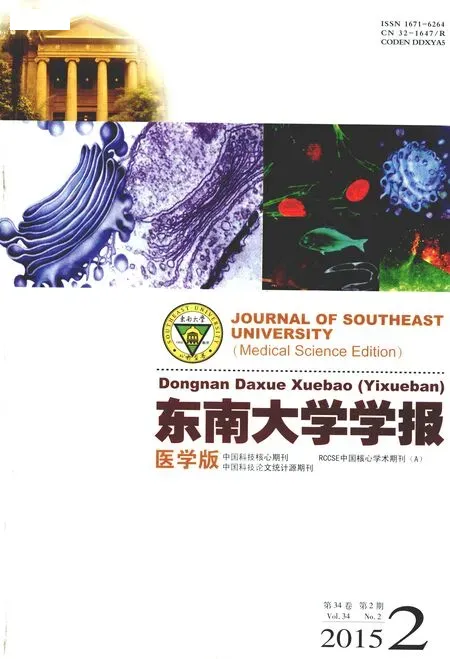6 Allergy and Immunology
2015-03-22
6 Allergy and Immunology
2015156 Anti-endothelin receptor type A autoantibody in lupus associated pulmonary arterial hypertension.ZHAO Jiangfeng(赵江峰),et al.Dept Rheumatol,Renji Hosp,Med Sch,Shanghai Jiaotong Univ,Shanghai 200001.Chin J Rheumatol 2015;19(3):156-159.
Objective To investigate autoantibody against endothelin receptor type A(ENRA-Ab)in patients with systemic lupus erythematosus associated pulmonary arterial hypertension(SLE-PAH).The possibility of autoantibody-mediated pathogenesis in the development of SLEPAH has also been explored.Methods ENRA-Ab in the serum of SLE-PAH and controls were detected by using a human ETRA epitope peptide-based ELISA.The clinical relevance of ENRA-Ab in SLE-PAH was analyzed.Proliferation of vascular smooth muscle cells(SMCs)and permeability of endothelial cells in vitro under the stimulation of polyclonal ENRA-Ab IgG were assessed.The expressions of PAH-related markers,i.e.,5-HTT,PDGFR-b,VEGF-A and PDGF-B were measured by qPCR.The effect of ENRA-Ab in vivo was also determined in a suboptimal dose monocrotaline-induced model with the assessment of right ventricle hypertrophy index and pathology parameters.Independent t-test,Tukey-Kramer test of variance analysis and Pearson's correlation analysis were used for statistical analysis.Results ENRA-Abs was presented in a higher occurrence in SLEPAH(35/85,41%)compared with controls(0/60;0,13/80,16%).There was a significant correlation between ENRA-Ab and echocardiograph estimated pulmonary arterial systolic pressure(r=0.392,P=0.002)in SLE-PAH.ENRA-Ab could promote SMCs proliferation,disrupt endothelial barrier and up-regulate PAH-related markers expression,which could be blocked in the presence of ETR antagonist.ENRA-Ab aggravated right ventricle hypertrophy and vascular remodeling in vivo.Conclusion ENRA-Ab is a new biomarker,in SLE-PAH,which may mediate PAH development in SLE.
(Authors)
2015157 Umbilical cord mesenchymal stem cell transplantation modulated Th17/Treg balance and delayed lupus progression in MRL/lpr mice.ZHANG Zhuoya(张卓亚),et al.Dept Rheumatol&Immunol,Drum Tower Hosp,Nanjing Univ Med Sch,Nanjing 210008.Chin J Rheumatol 2015;19(3):152-155.
Objective To explore the preventive effect of early umbilical cord mesenchymal stem cells(UC-MSCs)transplantation on MRL/lpr mice and the underlying mechanisms.Methods Fourteen 10-week-old MRL/lpr mice were labeled and numbered.They were randomly divided into 2 groups using random number table and injected with 1×106UC-MSCs or PBS via tail vein respectively.Proteinuria was measured with Bradford method every 4 weeks.All mice were sacrificed at the age of 28 weeks,with the level of serum anti-dsDNA antibody and IL-17 detected by enzyme linked immunosorbent assay (ELISA).Splenic Th17 cells,as well as regulatory T cells(Treg)were examined by flow cytometry.Data were analyzed with t test and Pearson's correlation test.Results The onset of proteinuria was delayed for 4 weeks in UC-MSC-treated group compared with that in the control group.At the age of 28 weeks,the 24 hour proteinuria[(1.78±0.17)mg vs(4.77±0.98)mg,t=2.99,P<0.05]and the spleen weight[(0.149±0.009)g vs (0.273±0.052)g,t=2.33,P<0.05]in UC-MSC-treated group were significantly lower than those in the control group.There was also a trend of the decline of serum anti-dsDNA antibody and IL-17 level after UCMSCs transplantation.Compared with those in the control group,both the percentage and the absolute number of Th17 cells were significantly decreased in UC-MSC-treated group[(0.90±0.19)%vs(2.81±0.50)%,t= 3.54,P<0.01 and(3.7±0.8)×105vs(19.3±3.7)× 105,t=4.12,P<0.01].Meanwhile,the percentage of Treg elevated after UC-MSCs treatment.The ratio of Th17/Treg was significantly lower in UC-MSC-treated group than that in the control group(0.11±0.03 vs 0.50± 0.09,t=4.23,P<0.01).Both the ratio of Th17/Treg (r=0.73,P<0.01;r=0.59,P<0.05)and serum IL-17 level(r=0.78,P<0.01;r=0.56,P<0.05)was positively correlated with the level of 24 hour proteinuria and anti-dsDNA antibody respectively in MRL/ lpr mice.Conclusion Early UC-MDCs transplantation helps to delay disease onset and ameliorate disease progression in MRL/lpr mice,which may act through the modulation of Th17/Treg balance.
(Authors)
2015158 Altered expression of miR-155 in peripheral blood mononuclear cells of rheumatoid arthritis patients.YU Ping(于萍),et al.Dept Rheumatol& Immunol,Kailuan General Hosp,Hebei United Univ,Tangshan 063000.Chin J Rheumatol 2015;19(3):148-151.
Objective①To screen for the miRNAs differently expressed in the peripheral blood mono-nuclear cells (PBMCs)of rheumatoid arthritis(RA)by microarray experiments.②To further evaluate the expression of miR-155 in PBMCs of RA.③To determine the relevance between the expression of miR-155 and clinical as well as laboratory features.④To test whether inflammatory mediators can induce miR-155 expression in PBMCs of RA. Methods①Total RNA was isolated from peripheral blood mononuclear cells obtained from 5 patients of RA and 5 normal controls.Expression profiling of miRNAs was performed in a microarray analysis.②MiR-155 was identified for further study by stem-loop real-time RTPCR based on SYBR-Green.PBMC from 26 patients of RA and 23 normal controls were collected.③Association between miR-155 and the clinical and laboratory features of RA was evaluated.④Induction of miR-155 following stimulation with TNF-α,IFN-γ and LPS of cultures of RA PBMCs was examined by real-time RT-PCR.Statistical analysis was done with student's t test,paired t test,and ANOVA,Spearman correlation.Results①Expression profiling of miRNAs revealed significant differential expression of 14 miRNAs,of which signal intensity changed over two times.MiR-155 was up-regulated in PBMCs of RA than in normal controls(t=9.218,P= 0.001).②The expression level of miR-155 had a positive correlation with serum CRP level(r=0.57,P= 0.002).③Expression of miR-155 was markedly up-regulated in PBMCs of RA after stimulated with TNF-α,IFN-γ and LPS,especially with TNF-α.Conclusion The expression of miR-155 is induced by stimulating TNF-α,IFN-γ and LPS.MiR-155 may be a regulator in RA pathogenesis.Further studies are require d to eluci-date the function of miR-155.
(Authors)
2015159 Association between cytotoxic T lymphocyte-associated antigen-4genepolymorphism and Graves ophthalmopathy in Qinghai Han population. WANG Shuqiong(王淑琼),et al.Dept Diabetes,People's Hosp,Xining 810000.Chin J Endemiol 2015;34(3):175-177.
Objective To investigate the association between gene polymorphism of cytotoxic T lymphocyte-associated antigen-4(CTLA-4)and Graves ophthalmopathy(GO)in Qinghai Han population.Methods Ninety cases of Graves disease were selected from June 2011 to February 2014 in The People's Hospital of Qinghai Province,and the 90 patients were divided into two subgroups according to GO(49 cases)and GD without GO(41 cases).Then the genotype and allele of CTLA-4 exon 1(+49A/G)were detected in surum by polymerase chain reaction restriction fragment length polymorphism(PCR-RFLP). Results The distribution of CTLA-4 exon 1(+49 A/G)genotype frequencies(AA,AG,GG)was not different between GO and GD without GO subgroups[4.1%(2/ 49)to 7.3%(3/41),44.9%(22/49)to 61.0%(25/ 41),51.0%(25/49)to 31.7%(13/41),Fisher exact probability,P=0.180>0.05];the distribution of CTLA-4 exon 1(+49A/G)allele frequencies(A,G)was not different between GO and GD without GO subgroups [26.5%(26/98)to 37.8%(31/82),73.5%(72/98)to 62.2%(51/82),χ2=2.622,P>0.05].Conclusion CTLA-4 gene exon 1(+49A/G)may not be a candidate susceptibility gene for Qinghai Han Go.
(Authors)
